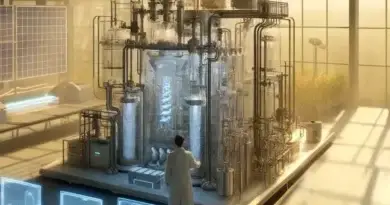Top CO₂-Capturing Enzyme Rubisco: New Insights

Rubisco, a key enzyme in photosynthesis, has long been a topic of debate among scientists. Traditionally perceived as inefficient, this enzyme is actually crucial for carbon fixation in a wide array of organisms, including plants, algae, and microorganisms. A recent study titled “Rubisco is Evolving for Improved Catalytic Efficiency and CO₂ Assimilation in Plants” by Bouvier et al. (2024) offers a fresh perspective on Rubisco’s evolutionary journey, challenging previous notions about its role and efficiency.
Understanding Rubisco’s Role
At the heart of photosynthesis, Rubisco initiates carbon fixation in the Calvin cycle. It adeptly converts carbon dioxide (CO₂) and ribulose bisphosphate (RuBP) into essential sugars, supporting plant growth and significantly influencing global carbon cycles. Despite its central role, Rubisco’s slow adaptation to present-day CO₂ and oxygen (O₂) levels has sparked widespread debate. Critics have questioned its efficiency and its potential for future adaptation.
The Rubisco Paradox
The so-called “Rubisco paradox” arises from the enzyme’s perceived sluggishness compared to its vital function in sustaining life on Earth. Bouvier et al.’s study confronts this paradox head-on, revealing that Rubisco is, in fact, evolving to become more efficient over time.
Evolutionary Insights into Rubisco Efficiency
The research sheds light on several critical aspects of Rubisco’s evolution:
- Gradual Evolution of RbcL: The large subunit of Rubisco, known as RbcL, evolves gradually. This slow yet steady evolution contrasts with the enzyme’s ongoing kinetic enhancements, suggesting a robust evolutionary drive to optimize photosynthesis.
- Selective Pressure in Angiosperms: The study highlights that Rubisco has been under consistent selective pressure to improve its catalytic efficiency in flowering plants (angiosperms). As a result, these plants exhibit enhanced photosynthesis rates.
- Role of RbcS Subunit: While the small subunit, RbcS, does not directly participate in the catalytic process, its role in enhancing Rubisco’s stability and assembly is undeniable. This contributes significantly to the enzyme’s overall kinetic efficiency.
Impact on CO₂ Assimilation
Evolutionary advancements in Rubisco have led to a notable increase in CO₂ assimilation rates among plants. This improvement underscores the enzyme’s finely tuned efficiency, aimed at optimizing photosynthesis and growth in diverse environmental conditions.
Challenging Outdated Views
The study’s findings compellingly challenge the outdated view of Rubisco as merely an evolutionary relic. Instead, they highlight the enzyme’s dynamic adaptability and the evolutionary pressures that have shaped its catalytic mechanisms for optimal CO₂ fixation.
The revelations from this study have profound implications:
- Bioengineering Potential: Understanding Rubisco’s evolutionary enhancements opens new pathways for bioengineering more efficient Rubisco variants. Such advancements could significantly enhance crop productivity.
- Carbon Sequestration Strategies: Improved Rubisco efficiency could contribute to more effective carbon sequestration, playing a vital role in combating climate change.
A Fresh Perspective on Rubisco
This new understanding of Rubisco not only underscores the enzyme’s intricate balance between stability, activity, and specificity but also opens avenues for future research. By exploring its genetic and biochemical foundations, scientists aim to unlock strategies for improving photosynthetic efficiency through innovative genetic engineering and plant breeding techniques.
Addressing Global Challenges
The potential benefits of such research are vast:
- Enhancing Agricultural Yields: Improved photosynthetic efficiency can lead to higher crop yields, addressing food security concerns.
- Combating Climate Change: More efficient CO₂ assimilation contributes to reducing atmospheric carbon levels, mitigating the effects of global warming.
The study redefines our understanding of Rubisco, highlighting its evolutionary progression and essential role in photosynthesis. Recognizing the enzyme’s adaptability and potential for further enhancement allows us to explore innovative solutions to some of the most pressing global challenges, including climate change and food security.
Keywords: Rubisco, Photosynthesis, Carbon Fixation, Enzyme Evolution, Plant Growth, CO₂ Assimilation, Bioengineering, Crop Productivity, Climate Change, Food Security
References
- Original Research Paper: Link to the article
Disclaimer: The information presented in this article is for educational purposes and reflects findings from current research. For more detailed information, please consult the original research paper or a qualified professional.



